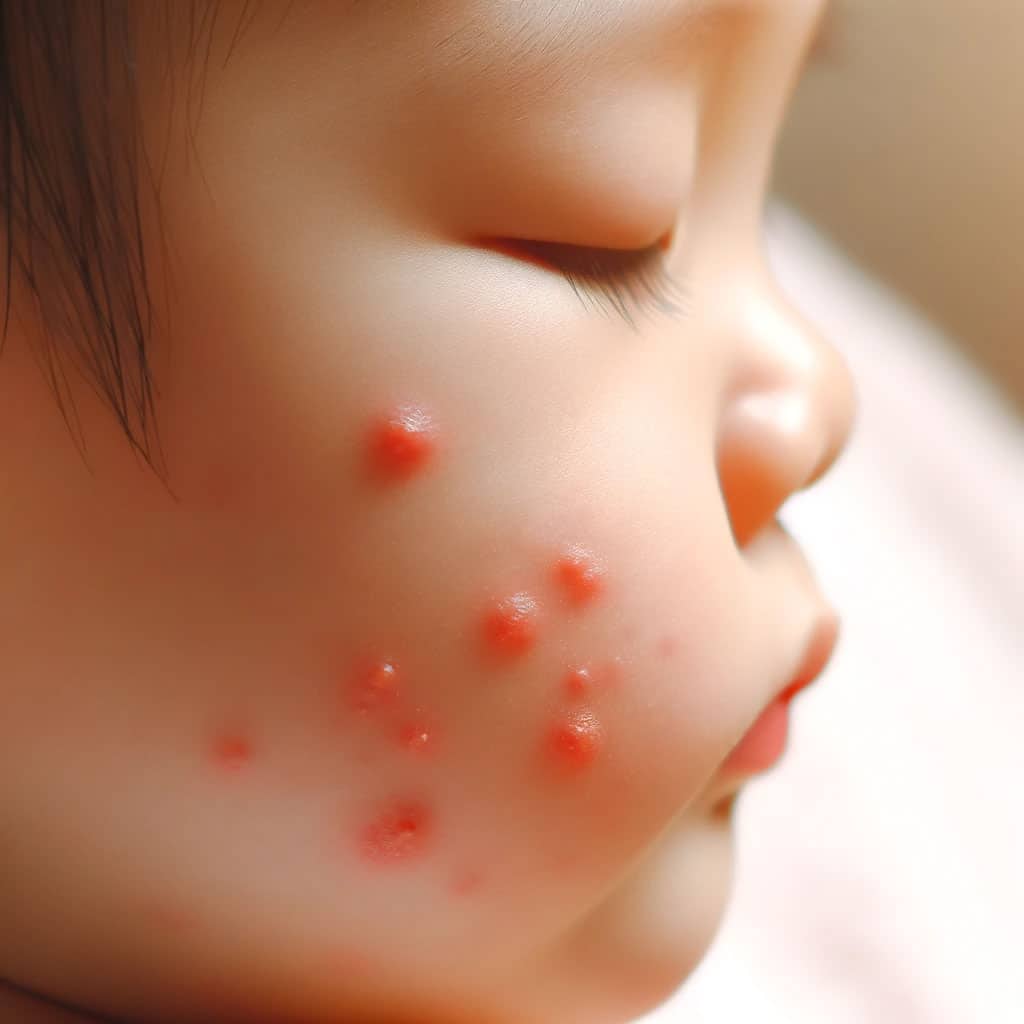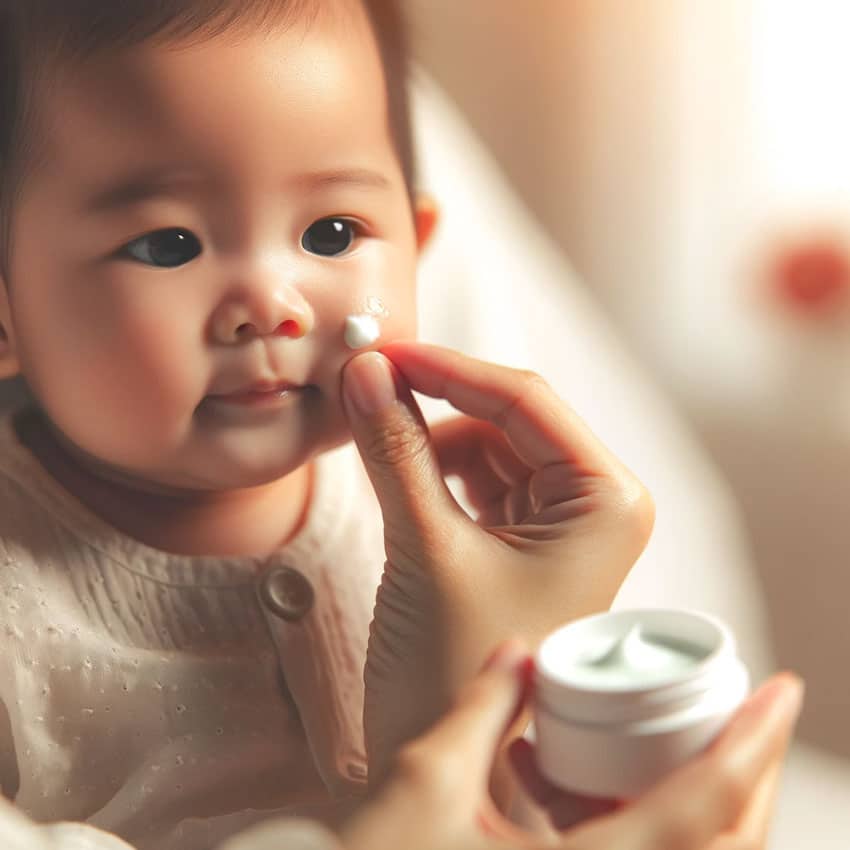Baby acne is a common skin condition that affects many newborns. It is characterized by tiny red or white bumps that usually appear on the baby’s face, neck, and back.
While baby acne is not a serious health concern, it can be distressing for parents who want their baby’s skin to look smooth and healthy.
Understanding Baby Acne
Baby acne is a common skin condition that affects newborns and infants. It usually appears on the face, neck, and scalp and is characterized by tiny red or white bumps or pimples.
Baby acne is not a serious condition and usually goes away on its own without treatment. However, it can be a source of concern for parents, especially if it persists for a long time.
The exact cause of baby acne is not known, but it is believed to be related to hormonal changes that occur during pregnancy and after birth.
Newborns are exposed to high levels of hormones from their mothers during pregnancy, which can stimulate the oil glands in their skin and cause acne. This is known as neonatal acne and usually appears within the first few weeks of life.
Infantile acne, on the other hand, usually develops between the ages of 3 and 6 months and is thought to be caused by the baby’s hormones. It can last for several months or even years, but it usually goes away by the age of 2 or 3.
The symptoms of baby acne are small red or white bumps or pimples on the baby’s face, neck, and scalp. They can be accompanied by redness and inflammation, but they are usually not painful or itchy.
Baby acne can sometimes be confused with other skin conditions, such as eczema or milia, so it is important to have it diagnosed by a healthcare provider.
In most cases, baby acne does not require any treatment and will go away on its own within a few weeks or months. However, there are some things that parents can do to help manage their baby’s acne and prevent it from getting worse. These include:
- Keeping the baby’s skin clean and dry
- Avoiding harsh soaps and detergents
- Using gentle, fragrance-free skincare products
- Avoiding tight-fitting clothing and hats
- Not squeezing or picking at the pimples
In rare cases, baby acne may be a sign of an underlying medical condition, such as a hormonal imbalance or an infection. If the acne is severe, persistent, or accompanied by other symptoms, such as fever or lethargy, it is important to seek medical advice.
Identifying Baby Acne
Baby acne is a common skin condition that affects newborns and infants. It usually appears on the face, but it can also develop on the neck, back, chest, and scalp. Baby acne is characterized by small red or white bumps, also known as pustules, that may be surrounded by redness. Unlike adult acne, baby acne does not have blackheads or whiteheads.
It is important to note that baby acne is a harmless condition that usually clears up on its own without treatment. However, it can be mistaken for other skin conditions, such as diaper rash or baby rash, so it is important to diagnose it correctly.
To diagnose baby acne, parents should look for small red or white bumps on the baby’s face, especially on the cheeks, nose, and forehead. These bumps may be surrounded by redness, and they may appear in clusters.
Parents should avoid pinching or squeezing the bumps, as this can cause infection and scarring.
It is also important to distinguish baby acne from milia, which are tiny white bumps that appear on the baby’s face. Milia are caused by blocked oil glands and usually disappear on their own within a few weeks.
If parents are unsure whether their baby has baby acne or another skin condition, they should consult a doctor or a dermatologist for a proper diagnosis.

Treating Baby Acne
Treating baby acne can be a bit challenging, but there are several things that parents can do to help alleviate the condition. Here are some tips:
- Keep the affected area clean: Clean the baby’s face daily with warm water, and use a mild, moisturizing facial soap every other day. Avoid scrubbing or rubbing the affected area, as this can worsen the condition.
- Avoid using lotions or oils: Avoid using any lotions or oils on the affected area, as they can clog the pores and make the acne worse.
- Use benzoyl peroxide sparingly: Benzoyl peroxide can be an effective treatment for baby acne, but it should be used sparingly and only under the guidance of a pediatrician.
- Apply ointments or creams: Applying a mild ointment or cream to the affected area can help soothe the skin and reduce inflammation.
- Consider medication: In severe cases, a pediatrician may prescribe a medication to treat the baby’s acne. However, this is usually only done as a last resort.
When to Consult a Healthcare Provider
In most cases, baby acne is a harmless condition that clears up on its own within a few weeks. However, there are some situations where it may be necessary to consult a healthcare provider.
If the baby’s acne is severe, persistent, or accompanied by other symptoms such as fever or lethargy, it may be a sign of a more serious condition and requires medical attention.
Additionally, if the baby has eczema or atopic dermatitis, which can look similar to baby acne, it is important to consult a healthcare provider for proper diagnosis and treatment.
If the baby’s acne is caused by inflammation or a yeast infection, a healthcare provider may recommend a medicated cream or other treatment. If the baby’s acne is caused by contact with irritants or allergens, the healthcare provider may recommend avoiding the trigger.
Breast milk has been known to help clear up baby acne, but if the baby’s acne persists despite using breast milk, it may be a sign of a more serious condition and should be evaluated by a healthcare provider.
In some cases, baby acne may be a sign of heat rash or other skin conditions such as blackheads, blemishes, or cysts. If the baby’s acne is accompanied by other symptoms such as itching or pain, it is important to consult a healthcare provider for proper diagnosis and treatment.

Preventing Baby Acne
Preventing baby acne can be a bit tricky, as many factors can contribute to its development. However, there are some steps that parents can take to reduce the likelihood of their baby developing acne.
One of the most important things parents can do is to take good care of their baby’s skin. This means washing their baby’s face with warm water at least twice a day and patting it dry gently.
It’s important to avoid scrubbing or picking at any acne that does develop, as this can make it worse.
Parents should also avoid using any harsh soaps or lotions on their baby’s skin, as these can irritate the skin and make acne worse.
Another important factor to consider is the type of yeast that can be present on a baby’s skin. This yeast can contribute to the development of acne, so it’s important to keep the skin clean and dry.
It’s also important to be aware of any skin problems that may run in the family, as these can increase the likelihood of a baby developing acne. If a parent or sibling has had issues with sensitive skin or adult acne, it’s a good idea to take extra care of the baby’s skin.

